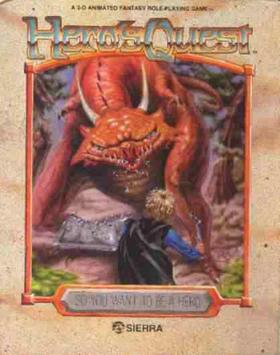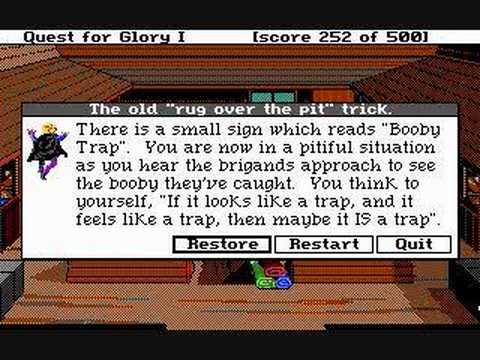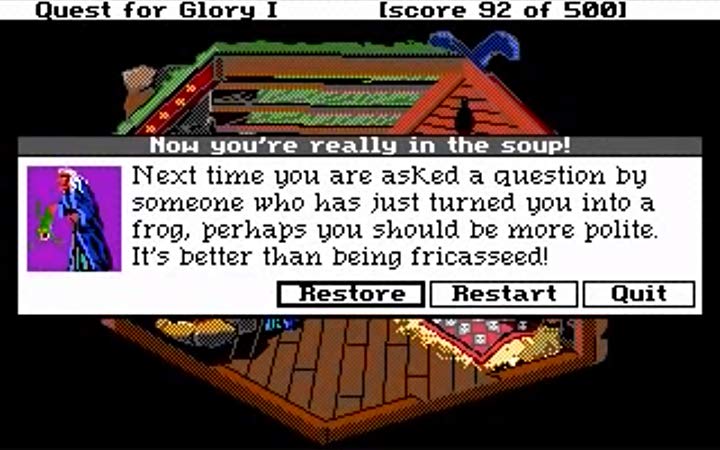RE:Play – Quest for Glory 1: So You Want to Be a Hero

REPOST: I’m going to be laid up for a while which means I’m in rerun mode. Enjoy these blasts from the past. Or don’t, because either way this is what you’re getting.
Today the monsters of PC gaming are well known to all Steam, EA, Sony, and biggest fish in any pond Microsoft. Huge multi-billion dollar corporations chugging out carefully crafted and polished money extraction software. Modern games require the kind of budget that epic blockbusters are made of. Quora estimated that Hogwarts cost about $165 million to develop. Modern PC gaming is a mega-industry of unearthly proportions with annual revenues exceeding the gross national product of most third world countries.
But before these modern gods of gaming Olympus, there were the titans of the primordial age. Infocom, Origin, Broderbund. And of course Sierra Online.
In the early days, if you wanted to be a game dev you didn’t need a multi-million dollar budget. You just found the On switch on your IBM clone (admittedly, that wasn’t always easy) and started programming.
The early eighties gaming market was ruled by Infocom and its headliner, Zork. They set the standard for their time and those games were entirely text driven.

Then the husband and wife power couple of Ken and Roberta Williams decided to try their hand at writing a game and added something no one had ever seen before. Graphics:

I won’t pretend that it was particularly amazing stuff, but it was a start. You could get a look at what you were supposed to be imagining. It was the genesis for Sierra Online.
Mind you, Sierra certainly had its ups and downs. Sierra had the Ultima series and didn’t hang on to it.
Worse still, the early gaming companies had an unfortunate tendency to blow themselves up in the wire by trying to get into business software, the only gaming company that ever managed it was Encom in the movie Tron. The movies was the only place that ever worked. Everybody else who tried it went bankrupt. Infocom had had the best start of all but their database, Cornerstone, became known as Tombstone in the industry. Sierra nearly met a similar fate but pulled out of it thanks to the massive success of their Quest titles. King’s Quest, Police Quest, Space Quest, Panty Quest (okay that series was actually that was called Leisure Suit Larry), all made major bank for Sierra. So at the sunset of the Eighties Sierra went back to the well one more time to launch the last of their Quest games. Hero’s Quest.
And after getting an infringement letter from Parker Brothers’ it became Quest for Glory. Although most of its fans doggedly called the series Hero’s Quest anyway because Gen-X.
Honestly, of all the Sierra Quest titles this one was my favorite.* It had charm, humor, and fun. Unlike King’s Quest, it actually felt a little like a D&D game night.
The title starts with an EGA dragon climbing over the top of the Sierra logo and roaring in a bloopy kind of way. And you never saw that dragon again for four games.
It was the first PC game I played that let you pick a player class.** Fighter, Mage, Thief. No Cleric and really none needed since this was a solo outing. You start by meeting the sheriff of the town of Spielburg. A very German-looking town and this was deliberate. The devs had wanted to set each of the games in one location with a very strong cultural motif.
Now before you begin the highest tech game that 1989 had to offer you would have needed paper and pencil. Seriously, this was not optional. You were going to have to draw something nearly unknown to Millennials and Zoomers. A map.
And this was not a simple map.

You will note that there are more blank squares than lettered squares. Nothing happens in those maps except random encounters with stuff that is going to kill you.
The other thing you needed was PATIENCE. Perhaps the devs thought that grinding was part of the fun but I don’t remember enjoying it all that much. However, grind you would if you were going to raise your stats.
They also seemed to think that getting randomly killed was a blast because that happened all the time too.



In its original iteration, Restore was not an option, you went back to your last save point and if you didn’t do that regularly you would lose a lot of ground.
I suppose the random deaths were part of the challenge, if not exactly “fun.” After a while, you might rage quit and dig through your collection of Star Trek NextGen VHS tapes and watch the adventures of a Captain Picard who didn’t suck yet. However, you would soon be back at it.
Hero’s Quest did have quite a bit of replay value. Your first time through you would probably play as a fighter as that was the easiest way to get through it with minimum grinding. Then Mage and lastly Thief. The thief was the most fun and had more unlocks than any of the other classes. That one had the Thief quests, the thieves guild, burgling houses, and climbing over walls when you needed to get into the safety of Speilburg at night.
Being outside of the town at night was not recommended, there would be a lot more monster encounters and not enough time to rest up and heal between attacks. There were a few sanctuaries that you might be able to get to in time if the sun was going down. The Castle stables were good but you would have to work for your shelter. You could use Erana’s Peace at the top map without any kind of cost but you would likely die of exhaustion running to it. Also, it was in a freaking cul-de-sac and if you missed your turn you would end up in the Ogre-bear’s cave.
One of the nice things about Hero’s Quest is that the classes weren’t completely segregated. For instance, if you left Magic at zero points when you generated your character you could never learn any spells but if you put five points there you could grind yourself up the magic ladder part way. Very useful for a Thief.
After you had defeated Baba Yaga and rescued the Baron’s brats and restored peace to the valley, you would get your victory cut scene. The one where the entire valley turns out to cheer you. One little court jester cartwheels, apparently forever, in celebration of your victory. You read the bubble that praises your amazing achievement in having wasted days of your life trying to get to this cutscene. You could then save your character and move on to the next Quest for Glory game. Which, I can’t really recommend because Quest for Glory II kinda sucks (Future DH, I ran into vociferous disagreement on that but my opinion hasn’t changed). Regardless, I did like Hero’s Quest III, IV, and V.
The Sierra would hang on to its marketshare into the nineties but wouldn’t significantly expand it.
Ken Williams had the chance to buy up a struggling start-up in 1992 called id software. They had just released a game called Wolfenstein3d and from what I’ve read, Williams thought the concept of a first-person shooter was a flash in the pan. Sierra stuck with what it knew, which was puzzle adventure games. By the time Williams thought better of it, Sierra was drastically behind the power curve. Sierra did publish the first Half-Life game but Valve moved on afterward.
In 2008 Sierra was shuttered.
Sierra Entertainment was revived by… *spits on the ground*… Activision to sell its old games, as well as being a venue for a few new ones. But it really isn’t the same. There was a crazy ambition to be the next Walt Disney in the old days that just isn’t there now. However, it has been recently torn from Activision’s clutches by it’s new corporate overlord Microsoft to be a vendor for indie games and a revived version of King’s Quest.
Regardless, all five Quest for Glory games are now available from GOG.com for the paltry price of ten bucks.
The Dark Herald Recommends with…fond remembrance.
*With Space Quest being a very close second.
** There may have been others before QFG but I honestly don’t care.

